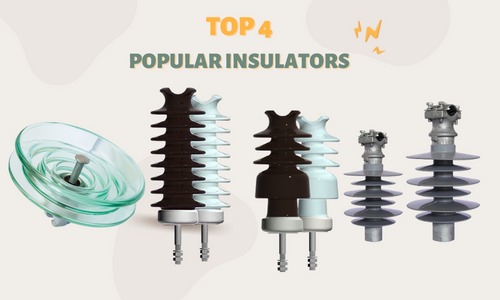News & Events
Top 4 popular insulators nowsaday

Top 4 popular insulators
Top 4 popular insulators
Insulators are materials that protect and prevent current from flowing, playing an important role in the construction of electrical circuits and overhead electrical systems. Insulators are often used to make insulating products that help prevent electric currents, ensuring safety for users. Referring to insulating products in the electrical industry today, let’s take a look at 504 Power’s list of the top 4 popular insulators in today’s transmission lines:
- Polymer Insulator
- Glass Insulator
- Porcelain Pin Post Insulator
- Porcelain Line Post Insulator
1. Polymer Insulator
A Polymer Insulator has two parts, one is glass fiber reinforced epoxy resin rod-shaped core and the other is silicone rubber or EPDM (Ethylene Propylene Diene Monomer) made weather sheds. The rod-shaped core is covered by weather sheds. Weather sheds protect the insulator core from the outside environment. As it is made of two parts, core and weather sheds, Polymer Insulator is also called a composite insulator.

Polymer Insulator
Advantages of Polymer Insulator
- It is very lightweight compared to other insulators.
- As the composite insulator is flexible the chance of breakage becomes minimum.
- Because this Polymer insulator is lighter in weight and smaller in size so it has lower installation costs.
- It has a higher tensile strength compared to other insulators.
- It has durability and life expectancy over 20 years.
- Good water resistance, corrosion resistance, outdoor installation, suitable for operating under humid tropical climates, polluted areas, ultraviolet (UV) rays, etc
Disadvantages of Polymer Insulator
- Moisture may enter in the core if there is any unwanted gap between core and weather sheds. This may cause the electrical failure of the insulator.
2. Glass Insulator
Nowadays Glass Insulators has gradually become popular, widely used in electrical transmission and distribution systems thanks to possessing numbers of advantages over conventional porcelain insulator.

Glass Insulator
Advantages of Glass Insulator
- Has a higher dielectric strength than conventional porcelain.
- High resistivity.
- Low coefficient of thermal expansion.
- Made from transparent glass, adapted to installation environments, tropical environments, not heated under sunlight.
- Glass has a very long life because the electromechanical properties of glass are not affected over time.
Disadvantages of Glass Insulator
- Moisture can easily be condensed on the glass surface and hence air dust will be deposited on the wed glass surface which will provide a path to the leakage current of the system.
Properties of Glass Insulator
|
Features |
|
| Dielectric Strength | 140kV/ cm |
| Compressive Strength | 10,000 kg/ cm2 |
| Tensile Strength | 35,000 kg/ cm2 |
3. Pin Post Porcelain Insulator
Porcelain Pin Post Insulator is used to support power cables and insulate power transmission and distribution lines of medium voltage grids and substations.

Porcelain Pin Post Insulator
Advantages of Porcelain Pin Post Insulator
-
Porcelain Pin Post Insulator is made of Porcelain ceramic material, enameled and fired at extremely high temperatures, so it has good electrical insulation, water resistance, high tensile and compressive forces, corrosion resistance, dust resistance, Low expansion number, long service life.
-
Suitable for environments with humid climates, seas, and hoarfrosts.
Disadvantages of Porcelain Pin Post Insulator
- It applies only to transmission lines.
4. Porcelain Line Post Insulator
Porcelain Line Post Insulator is designed to provide rigid support of conducting cable while offering the maximum resistance to damage from electrical or mechanical events. It is made of Porcelain ceramic, coated with enamel and fired at extremely high temperatures.

Porcelain Line Post Insulator
Advantages of Porcelain Line Post Insulator
- High mechanical strength, 1 ~ 2 times higher than that of porcelain insulator.
- Stable performance, not aging, good electrical insulation, water resistance, and low expansion coefficient.
- Less production process, convenient for mechanization and automation production, high production efficiency.
- The weight of ceramic insulator is light.
- Use for polluted environments.
Disadvantages of Porcelain Line Post Insulator
- Due to the transparency of ceramic insulator, it is easy to find small cracks and various internal defects or damage during external inspection.
- Due to manufacturing technology and other reasons, the “self-breaking” rate of ceramic insulator is high, which is the fatal defect of ceramic insulators.
Where to buy insulation products?
Currently, on the market there are many businesses that sell popular types of insulators that you can find and buy. 504 Power is proud to be one of the reputable units specializing in providing all kinds of electrical materials and equipment for lines and substations that meet IEC quality standards with competitive prices.
Hopefully, with the information about the top 4 types of insulators above, you can understand the common types to apply to the selection and use of insulators for lines. Immediately contact the hotline 0963 757 504 for the fastest advice and support from 504 Power





